How to Arrange Golf Clubs in a Bag?
Knowing how to arrange your golf clubs in your golf bag isn’t something that’s taught when picking up the game. But to play good golf, you need a clear mind, yet you’ll be amazed by how many golf bags look like the reduced shelf in a supermarket.
While it seems like a small detail, this can make a huge difference to how comfortable and accessible your clubs and other important equipment are throughout the day, and it’s best to make sure everything is organised correctly before you start to avoid frustrations which can actually impact your play and how much fun you’re having.
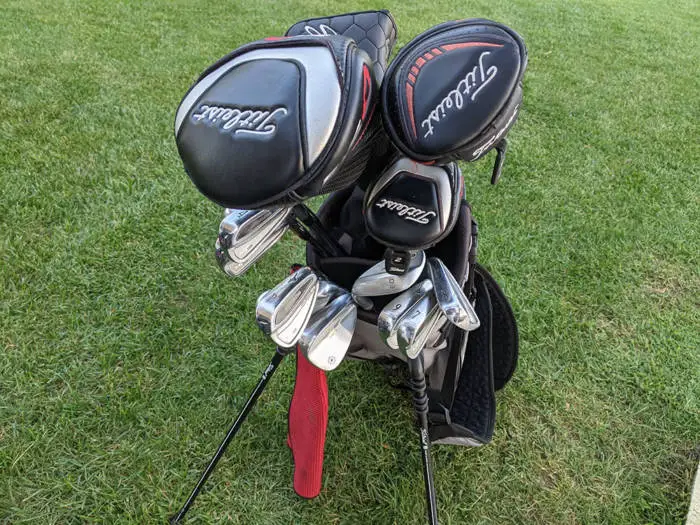
Golf bags come in a range of shapes and sizes, but generally there is a proper way to set up and use a golf bag to ensure your clubs are secure and safe, as well as easily accessible when you need them.
The structure of the bag and its pockets are set up to allow you to store the various clubs in such a way that they don’t knock each other or become damaged while being carried too, which is another reason why setting your bag up correctly is so important.
In this guide we’re going to explain how to arrange your clubs in the optimum way and how to use your golf bag to its maximum, so that you can make your whole day on the course much more enjoyable.
First, let’s take a look at how to arrange your clubs.
How to arrange your golf clubs
If your golf bag is a bit of a mess, follow the steps below to arrange your clubs.
Step 1 – Empty your golf bag
The first thing you need to do when arranging your golf clubs is to ensure that your golf bag is totally empty and clean.
Take all the clubs and accessories out of your bag and line your clubs up on a flat surface or against a wall in order of length from the driver all the way down to the putter.
Step 2 – Go through the pockets
Throw away any rubbish out of your bag such as receipts, old towels that are well overdue a wash, rogue tees, broken pencils, chocolate bar wrappers and other bits that need to be put to one side or gotten rid of so you can properly organise your pockets and accessories later.
An optional step here is to clean your bag and your clubs if they’re overdue a wash. This can improve not only their longevity but their performance as well (in the case of clubs). Noone likes a golf bag which smells like damp, so look after your bag and it will look after you and your clubs!
Step 3 – Load the longest clubs
Whether you’re using a stand bag or a cart bag, most bags are structured to accommodate the clubs in a certain manner. Each golf bag will have a different number of top dividers. Stand bags will typically have 4 or 5 whereas a cart bag may have 14 – a separate divider for each club. However the principle is the same, accommodate the advice according to the bag you have.
Start with the longest clubs. The driver and woods (or any with a headcover) should be added into the top of the bag near the strap attachment point. This is the area of the bag with the longest clearance between the top of the bag and the bottom to allow your longest clubs to sit snugly and secure inside the bag without them falling out or dangling out too much.
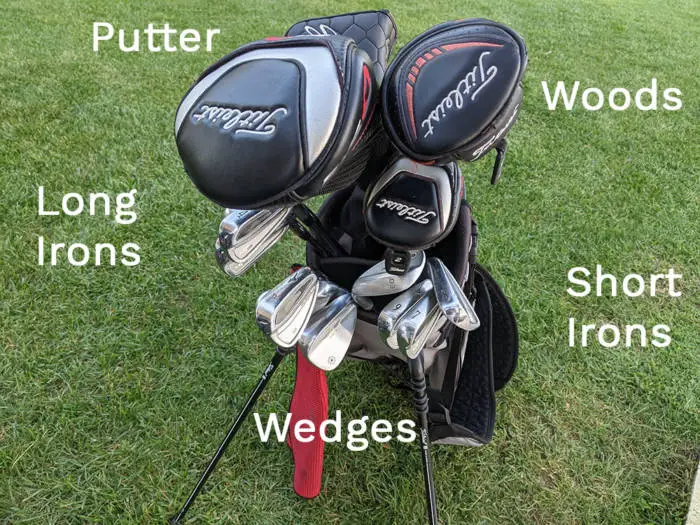
If you use a cart bag, you may have numbered slots for your clubs, in which case the driver is inserted into the upper left hand compartment, and then you insert your clubs in descending order from left to right as you work your way down the clubs.
Once the driver, woods and hybrids are in place in these larger pockets it’s time to insert the irons.
Step 4 – Follow with the irons
In a cart bag simply continue working your way down the clubs going from left to right with the compartments.
For a stand bag or smaller bag, you can place your irons in the middle compartments. Generally, the longer irons are best placed closer to the driver and woods (or from left to right) to create a pattern of order, making it easier to select and withdraw the right club as you need it.
Step 5 – Add the rest
Putters and wedges are among the shortest clubs, and require the least space and amount of depth in the golf bag. As such, they are usually placed in the front of the bag where there is the least amount of space.
For a stand bag, the putter and short wedges usually go in the final compartment near the front of the bag with the noticeably shorter compartments.
Disclaimer: I personally prefer my putter in the top compartment with my woods and other clubs with headcovers. This is because I only carry 3 woods but 4 wedges, so there’s plenty of space higher up. Tweak your set up as you see fit depending on which golf clubs you carry in your bag.
Again for a cart bag, continue adding your clubs in descending order going from left to right.
Step 6 – Add the accessories
Now that your clubs are in place, you can add all the other accessories and equipment you need back to your bag, making sure everything is organised and where you can easily reach it.
Overloading your bag is never a good idea (if you’re carrying) as this can make the day exhausting, but there are essential things all golfers should carry including spare balls, tees, pencil, towel, hat, waterproofs and even a spare glove. A drink and a snack are also a good idea.
Not all bags have the best pocket arrangements to accommodate all of this, but many will at least have space for a few essentials.
All golf bags usually have a full zip pocket down the outside of the golf bag. This is best suited to store any extra clothing such as golf waterproofs, an extra layer, or your hat and mittens if it’s cold. Make sure you fold the clothing well to make the best use of the space. I also store the rain cover which goes over your clubs when it’s wet in here.

Next you’ll want to separate your valuables to avoid them getting damaged whilst out on the course. Most good golf bags will contain a well lined and protected pocket for you to store your phone, wallet, watch, car keys etc.
You’ll notice on the image below that the zip is slightly different on this pocket. Even though the golf bag isn’t waterproof, the valuables pocket is to help better protect your important items – a good feature to look out for if you’re in the market for a new golf bag. If you want to go one step further you could also get a fully waterproof golf bag – you can check the best ones here.
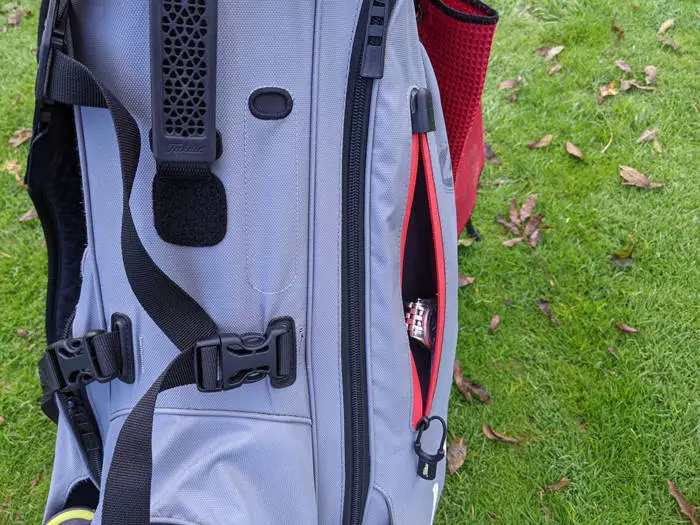
99% of golf bags will contain a pocket at the base of the bag. This is the ball pocket and is used for storing, well, golf balls. I usually carry another half a dozen golf balls in my bag each time I hit the course (just in case).
Here I also store my golf gloves (both normal and rain golf gloves) and my tees, pitchmark repairer, ball markers and pencils. To avoid it getting messy with all that stuff, or avoid stabbing your finger with a tee or pencil (you’ll know the feeling if you’ve done it) I keep all those bits in a separate tote bag.
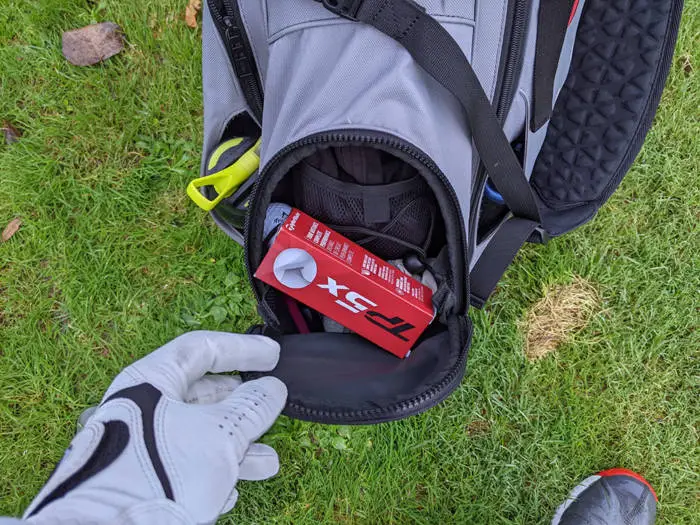
Finally there’s usually another pocket at the base which is on the inside of the golf bag (the side that sits against your back). This is probably the easiest to reach pocket when carrying your golf bag so comes in handy to keep your drink (most bags like mine below have a seperate drinks sleeve), any snacks, your scorecard and GPS or rangefinder.
As this pocket is at the base of the bag, try not to overload it with heavier items. You already have the golf ball pocket here which can weigh quite a bit and if you start to pack the base with lots of heavy stuff, it can throw the balance of your golf bag off and you’ll be forever adjusting the straps on the way round to make this comfortabe!
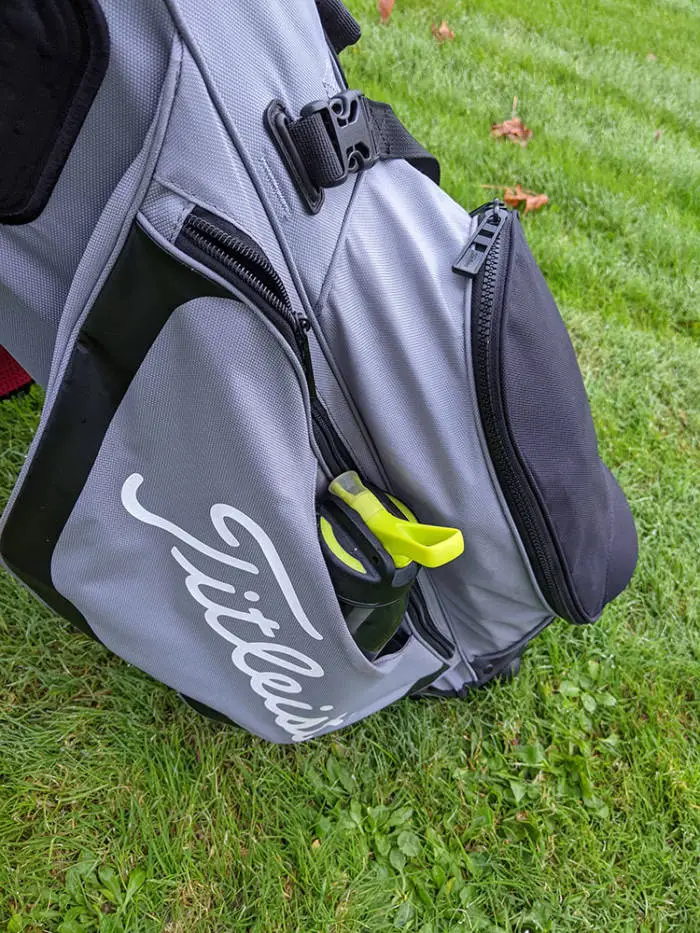
And that’s it. Follow these simple steps and you’ll have your golf bag set up like a pro with no excuses on the course.
If your bag isn’t quite up to scratch, check out our guides to the best carry golf bags and the best golf cart bags to use with a trolley which contain the key consideration factors when deciding which bag to buy.